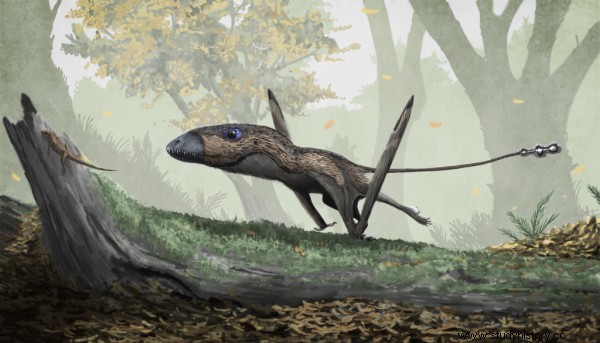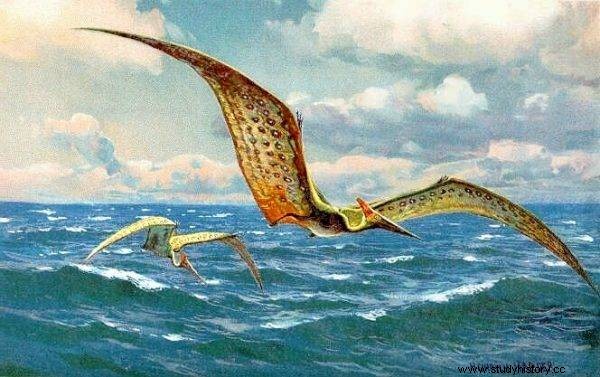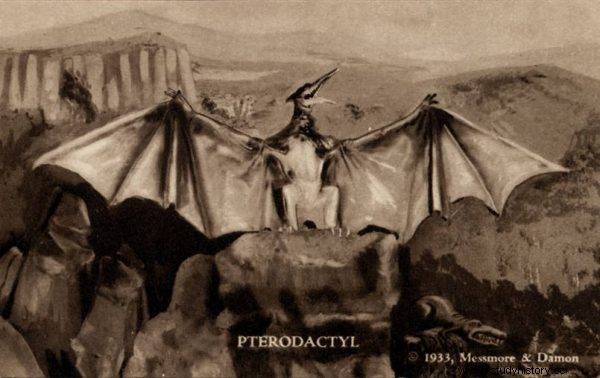For 155 million years they dominated the skies of the world of dinosaurs. From the smallest - the size of a sparrow to giant flying dragons, with wings spanning up to several meters. We are talking about pterosaurs, of course. Scientists believe that these flying reptiles died out 65 million years ago, but there are people who track them frantically all over the world. They are convinced that pterodactyls still live in distant corners of the globe and soar into the sky on their great wings.
We call people who believe in the existence of various animals, not recognized by science, cryptozoologists. Some of the supposedly living creatures targeted by these home-grown seekers have become a permanent fixture in mass culture - from the Loch Ness Monster to Chupacabra in South America to Yeti in the Himalayas and Bigfoot in the Rocky Mountains.
However, while the alleged "evidence" for the existence of these fanciful creatures is really meager, in the case of pterosaurs, the "evidence" is much richer . Believers in their existence show not only nineteenth-century photos of the corpses of flying reptiles, but also have a multitude of witnesses who say that they saw giant flying reptiles with their own eyes. So is it really a bang on the springs, or is there a grain of truth in these reports?
Eye to eye with the lizard
According to the International Society of Cryptozoology, pterosaurs have been observed in many places around the world - including in the Sierra Madre mountains in Mexico, Brazil and Africa. There are so many reports about giant reptiles from the suborder of pterodactyls that it is impossible to get over the matter.
In modern times, one of the most famous cases (the case was described, among others, by "The Telegraph") were the events in Alaska in 2002. The pilot John Bouker, along with the passengers, encountered a powerful monster during the flight. Bouker was on a course to Manokotak, a city in the southern half of the state. It was then that the creature with huge wings was to appear to him and the passengers. He determined their length to be 14 feet - the length of the Cessna's wingspan.

According to the International Society of Cryptozoology, pterosaurs have been observed in many places around the world - incl. in the Sierra Madre Mountains of Mexico, Brazil and Africa.
Bouker's adventure is not the only such report from Alaska. There are also newer reports. Three years ago, in 2018 - as the local daily from the state capital Juneau Empire describes - the giant creature was to be seen by many residents in the Mendenhall Valley area. Among them was Tabitha Bauter, who later reported:
I was just driving through the valley when I noticed a huge black bird flying over the road. The wingspan had to be at least 20 feet - almost as wide as a road. I've lived here my whole life and I've never seen anything like it. That scared me. It wasn't a raven or an eagle. This is not a joke. This thing was HUGE, almost the size of a small plane. Has anyone seen it?
Interestingly, the woman claimed that the animal had feathers, but did not see the beak. In response to her words, several other witnesses admitted seeing a mysterious giant "bird".
We know more of similar reports from the United States. A series of alleged encounters with pterosaurs was recorded in the 1970s in Texas. The local media wrote about it, the television even showed traces belonging to the supposedly flying creature. They were supposed to be 12 inches or 30 cm.
A man named Alverico Guajardo, who lives in a trailer in Brownsville, Texas, said that he suddenly heard hum, bangs and knocks outside. As he left, he saw a huge creature that resembled a bird, but was not . Guajardo stated that this animal was "not of this world."
His account triggered an avalanche. Similar stories from witnesses followed, and the local radio station even offered a reward for finding the pterosaur. Today it is difficult to say whether people actually saw something strange, or rather wanted to see it, on the wave of fashion that prevailed in this part of the USA at the time. At that time, scientists in Texas discovered a well-preserved skeleton of a pterosaur of the genus Quetzalcoatlus with a wingspan of 36 feet, or nearly 11 meters.
Wanted dead or alive
Cryptozoologists have been looking for flying reptiles for decades. So far, to no avail. In the late 1980s, Professor Roy Mackal, a doctor of biology and an avid cryptozoologist, went to Africa for this purpose (he was unsuccessfully looking for the Loch Ness monster, as well as a creature allegedly living in Africa - Mokele-Mbembe, supposed to look like a prehistoric brontosaurus or diplodok).
Prehistoric creatures are said to have been seen in western Zambia. According to the tales of Kaonde locals, the flying creature in Zambia's Jiundu marshes was similar to a large lizard, with a long crocodile tail and a toothed beak. He flapped large wings similar to those of a bat. The natives called the creature Kongomato. Similar reports come from other regions of Africa - incl. from Angola, Tanzania, Zimbabwe or Zaire.
The news of flying dragons this time came from the desert areas of neighboring Namibia. There allegedly were to live huge (with a wingspan of up to 30 feet) animal gliders, moving in the air in the evening time between the hills. However, the expedition ended in a fiasco.
Another famous expedition was undertaken in 2009 by the American cryptozoologist Garth Guessman. In order to "catch" the pterodactyl, Guessman traveled as far as Papua New Guinea. There it was, in the Papuan jungle, according to the natives, a ropen - as they called it - a mighty flying reptile.

Cryptozoologists have been looking for flying reptiles for decades. So far to no avail.
The researcher approached the matter professionally. His team included, among others pterosaur expert Dr. Dave Martill of the University of Portsmouth and people who know the habits of bats. Guessman rightly assumed that perhaps what the natives saw was not a prehistoric reptile at all, but a hitherto unknown species of bat.
Many accounts of strange creatures living on the islands of Oceania have been preserved. American soldiers mentioned them already during World War II. In modern times, the sensational bomb was launched by a certain Brian Hennessy, a psychologist working at the Chinese university Chongqing University of Medical Sciences. He began to talk publicly about his encounter with a pterodactyl in the Guinean jungle in the 1970s. In 1971, on the edge of the tropical forest of Bougainville Island, he heard first the flapping of wings, then he saw a great flying creature:
It seemed to be something archaic, prehistoric, not covered with feathers like birds . It had a long, narrow tail. The beak was also long and there was a horn on the back of the head.
Papuans were even supposed to point out a cave by the waterfall, where ropens often appeared. According to the natives' accounts, in the 1960s the tribal warriors even managed to hunt one of them and eat them. Apparently he didn't have tasty meat. However, the researchers did not reach any witnesses who would confirm this. The ropen itself was not found either. A similar expedition was also undertaken by, among others Jonathan Whitcomb. And he didn't come face to face with ropen.
Dragons, Chupacabra and Thunderbird
Despite the failure of the pterosaur searches so far, people who believe in their existence maintain their hypothesis. In their opinion, it is pterodactyls and other flying reptiles that could explain a number of reports and legends about strange creatures that have accompanied mankind since ancient times.
Perhaps this is what the legends of dragons say about them? Or is the pterosaur hiding behind the mysterious Chupacabra - a South American creature that is supposed to raid pets and suck their blood out of them? Perhaps, finally, prehistoric reptiles "are responsible" for the legend of the Thunderbird, an alleged mighty bird that was supposed to have a wingspan of 5 meters and look like a huge eagle? The North American Indians believed in the existence of a powerful "storm bird.
Reptiles and cowboys
Proponents of flying reptiles, still alive today, provide one more "argument" to confirm their revelations. Pictures. On the internet, it's very easy to find photos of people with alleged pterosaur bodies.
Two of the most popular ones are 19th century, made in the USA. American farmers pose on one of the reptile bodies, and on the other - soldiers. In 2011, another photo of a group of men with the body of a reptile with large wings appeared on the Internet. The problem is that it is not known who exactly the photos show, as well as when and where they were taken.
There are no witnesses who would confirm their authenticity, and such meetings with living fossils are not everyday. Their memory should survive in local communities, as well as the names of those who, for example, hunted the pterosaur. Although the photos look plausible at first glance, the lack of context and additional information raises the suspicion of forgery.

Perhaps this is what the legends of dragons say about them?
Secondly, photographic "evidence" seems to disappear in our times, and yet if pterosaurs were alive (unless they did not survive to the 21st century), today, when recording everything on a large scale has become an everyday reality, we should have a flood of various photos and videos confirming them existence. People in the modern era are also more mobile. They reach and record various images in the farthest corners of the globe - and yet pterodactyl video materials do not flood the web. We also do not know of any confirmed case of a pterosaur corpse.
There is another problem with the various reports and photos of alleged pterosaurs. From the fake news, prepared information and multimedia that flood the web every day, it's really hard to get the information that corresponds to reality. So for now, the reptiles from millions of years ago hovering over the human world still belong only to the realm of urban legends and fantastic stories.
